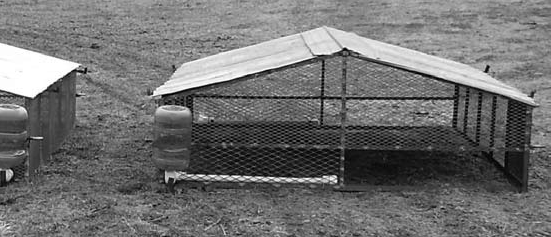By Diane Schivera, MAT
Introduction
The basis for organic livestock production is the development of a harmonious relationship between land, plants, and livestock, and respect for the physiological and behavioral needs of livestock. This is achieved by:
- Providing good quality organically grown feed
- Maintaining appropriate stocking rates.
- Designing husbandry systems adapted to the species’ needs.
- Promoting animal health and welfare by:
- minimizing stress,
- maintaining animal health with sound management,
- emphasizing cleanliness,
- moving away from the regular use of health care products.
Housing Space Per Bird
Replacements
- 1/3 ft2 until 3 weeks, inside
- 1.5 ft2 until 16 weeks
- After 4-6 weeks, depending on outside temperatures, birds are required to have access to the outdoors
Laying Hens
- 1.5 – 2 ft2 inside, 8-10 ft2 outside, 6-10 in. perch space
Meat Birds
- The standard “Chicken Tractor” is 10 x 12 ft. for 75-90 birds. Needs to be moved daily or the birds will be too crowded.
- 3 ft2 per bird. Another option is to use poultry netting and allow 15 ft2 per bird for the season. Need some cover for weather protection
Clean bedding: added to the top or changed regularly.
Feeder Space Per Bird
- Replacements: 1-2 in.
- Layers: 2-3 in.
- Meat Birds: 6 in.
Feed Consumption Per Bird
- Replacements: 15 lb. to 16 weeks
- Layers: .2 -.25 lb./day, 1.5 – 1.75 lb./week, 6 –7.5 lb./month, 72-90 lb./yr
- Meat Birds: 10-20 lb. to 8 weeks
Set feeder height so it is level with back of bird when standing and only fill half way to reduce feed waste.

Feed Ingredient Restrictions
- All feed must be organic, no feed/vegetable scraps that aren’t organic.
- Synthetic methionine is allowed until 2008.
- Fishmeal is allowed to supply methionine, if discussed with certifier
Water Space Per Bird
- .5 to 1.5 ft2 as they grow
Health care
- Birds must be managed organically from the 2nd day of life
- No non-permitted substances in feed, healthcare products or house structure.
- Vaccinations are allowed
- For specific treatments, see Raising Organic Livestock in Maine: MOFGA Accepted Health Practices, Products and Ingredients (available on www.mofga.org, or by calling the MOFGA office at (207)568-4142).
Processing/ Marketing
Eggs
- Must be clean. Sand lightly or wash to sell.
- If not washed, there is no need to refrigerate if selling within 7 days.
- Washed eggs must be refrigerated immediately after drying at or below 45o F.
Meat
- If you are slaughtering less than 1,000 birds per year, you can sell them from the farm gate.
- Grower/Producers (“G/P”) –those slaughtering less than 5000 birds per year– can sell anywhere. A state inspected facility is required.
- It is also possible to sell birds live and then transport them to a custom facility. A permit from the Dept. of Ag is required.
Last published November 2007
